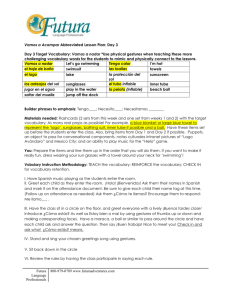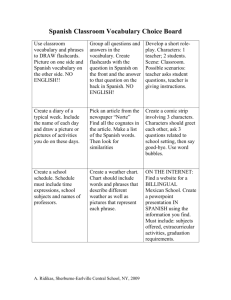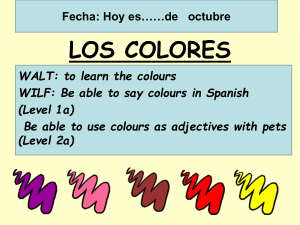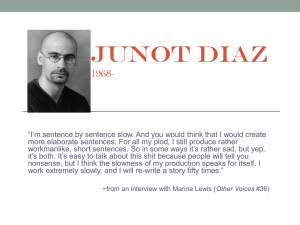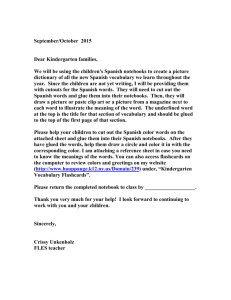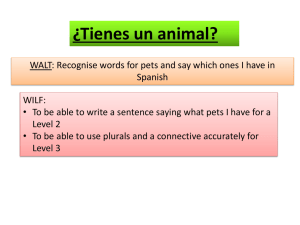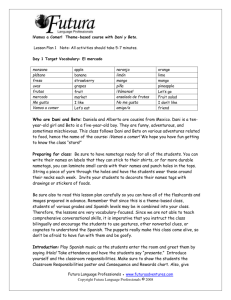Level I - Futura Language Professionals
advertisement
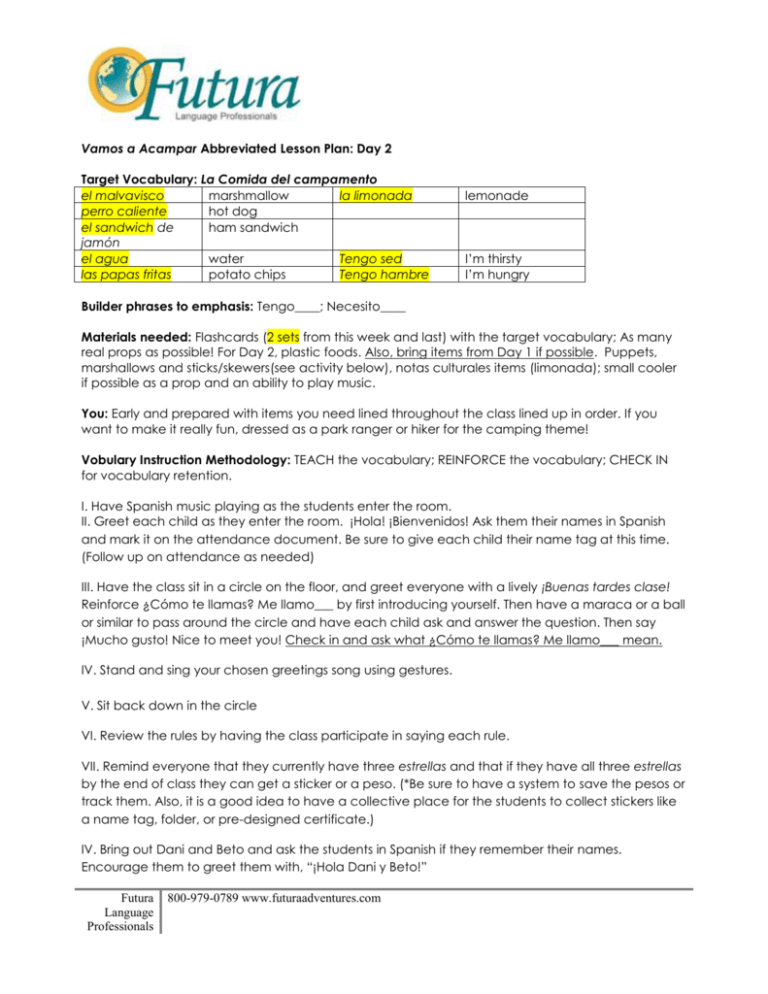
Vamos a Acampar Abbreviated Lesson Plan: Day 2 Target Vocabulary: La Comida del campamento el malvavisco marshmallow la limonada perro caliente hot dog el sandwich de ham sandwich jamón el agua water Tengo sed las papas fritas potato chips Tengo hambre lemonade I’m thirsty I’m hungry Builder phrases to emphasis: Tengo____; Necesito____ Materials needed: Flashcards (2 sets from this week and last) with the target vocabulary; As many real props as possible! For Day 2, plastic foods. Also, bring items from Day 1 if possible. Puppets, marshallows and sticks/skewers(see activity below), notas culturales items (limonada); small cooler if possible as a prop and an ability to play music. You: Early and prepared with items you need lined throughout the class lined up in order. If you want to make it really fun, dressed as a park ranger or hiker for the camping theme! Vobulary Instruction Methodology: TEACH the vocabulary; REINFORCE the vocabulary; CHECK IN for vocabulary retention. I. Have Spanish music playing as the students enter the room. II. Greet each child as they enter the room. ¡Hola! ¡Bienvenidos! Ask them their names in Spanish and mark it on the attendance document. Be sure to give each child their name tag at this time. (Follow up on attendance as needed) III. Have the class sit in a circle on the floor, and greet everyone with a lively ¡Buenas tardes clase! Reinforce ¿Cómo te llamas? Me llamo___ by first introducing yourself. Then have a maraca or a ball or similar to pass around the circle and have each child ask and answer the question. Then say ¡Mucho gusto! Nice to meet you! Check in and ask what ¿Cómo te llamas? Me llamo___ mean. IV. Stand and sing your chosen greetings song using gestures. V. Sit back down in the circle VI. Review the rules by having the class participate in saying each rule. VII. Remind everyone that they currently have three estrellas and that if they have all three estrellas by the end of class they can get a sticker or a peso. (*Be sure to have a system to save the pesos or track them. Also, it is a good idea to have a collective place for the students to collect stickers like a name tag, folder, or pre-designed certificate.) IV. Bring out Dani and Beto and ask the students in Spanish if they remember their names. Encourage them to greet them with, “¡Hola Dani y Beto!” Futura Language Professionals 800-979-0789 www.futuraadventures.com V. Remind the students that Dani and Beto are camping (a acampar). Have the class say with you, “¡Vamos a acampar!” VI. Theme song: Stand and sing the theme song with gestures*. Vamos a Acampar (Sing to the tune of the Farmer in the Dell) Vamos a Acampar Vamos a Acampar Con mis amigos, voy a acampar VII. Review the vocabulary from last week: Have the objects or pictures from last week set around the room. Have the students march around the room with and point to each object, saying the name of it in Spanish. (Alternately, hold up the flashcards and have the students repeat the woreds after you for a very short review.) Then play a review game by returning to the circle and explaining the game while everyone is sitting: Baile del campamento: This game is similar to dance freeze. Put on music and encourage the kids to dance, not run. When you stop the music whoever moves first must answer a vocabulary word question in Spanish. VIII. Teach the new vocabulary: Gather the students back into the circle. Pull out Dani and & Beto and the mini cooler that is packed with either the flashcards or the plastic food objects. Dani: Tengo hambre. I am hungry. (Have the class repeat and explain that tengo means I have. Ie: I have hunger, literally. Reinforce tengo) Beto: Tengo_____ (Insert each food vocabulary word as you hold it up, having the students repeat the word after you. ) Beto: Tengo sed. I am thirsty.. (Have the class repeat and explain that tengo means I have. Ie: I have thirst, literally. Reinforce tengo) Dani: Tengo la limonada y el agua. Encourage the students to repeat both words. Beto: Está bien. ¡Vamos a acampar! Let’s camp! Clase, vamos! IX. Reinforce the vocabulary: Move to a different area of the room and have the students sit down. In the circle hold up the objects and/or the flashcards again and have each student repeat the words after you. Speed it up as they start to remember to make it more fun. IX. Check in to see if the kids know the vocab: Lay out the objects/flashcards. (You can include the items from last week too.) Call out a vocab word in Spanish by saying the builder phrase Necesito + the object and have volunteers point to the corresponding object. Alternatively, you can hold up the objects/cards and have the students say the words when you ask ¿Qué necesitas? and they answer Necesito + the object. This is a very important step before moving to a game. X. Juego- Juego: Comida pop up game-You will need the picture flashcards of the food and drink items. Gather your students and sit in a circle. Hand each student a picture of one of the vocabulary words. You may need to repeat words. Let the students know that they should pop up when you call their food or drink item. For example: When you call out las papas fritas, the student(s) with that picture should jump up. *Tip: Have the students rotate cards after you have called out all of the vocabulary. Make the second round more difficult by challenging them to pop up and call out the word in Spanish at the same time! *Alternate activity for older students: Play a variation of Family Feud. Divide the students into two teams. Have one person from each team come up to the front of the room and put a bell or a buzzer onto a desk or table in the middle of the two students. Hold up a picture of a vocabulary Futura Language Professionals 800-979-0789 www.futuraadventures.com word from this or the previous class. Whoever rings the bell or pushes the buzzer first has the first opportunity to say the answer. If the player calls out the correct word in Spanish, he or she scores a point for his or her team. If the answer is incorrect, the other team has an opportunity to steal the point. Keep playing for 5-7 minutes or until every player has a turn. *** Remember to have students paired to compete by skill level. XI. Reinforcement Activity: Divide the class into two teams. Give each team a set of today’s flash cards. Tell the teams they need to race to put them into two piles Tengo hambre or tengo sed. Once they think they are done. They need to say Tengo hambre + the object in Spanish and Tengo sed + the object in Spanish. Have the whole class repeat for reinforcement. Alternate juego/reinforcement activity: Play a game similar to mata la mosca. Explain that the flies (las moscas) keep bothering Dani and Beto at the camp site. --So they need to swat them! Put out the flashcards or objects and call up two students and give them fly swatters. Say a word in Spanish and then the child who “swats” the object or flashcard first, wins. Give high fives to the winners and then repeat each word out loud as a group for reinforcement. (This can include vocab from last week as well.) XII. Merienda Y Notas Culturales: Have the students get their snacks and go sit at the table quietly while you teach the culture portion of today’s class. Remember this cultural part is not optional! Suggestion: Talk about some of todays foods in Mexico or another Spanish-speaking country. For example: In Mexico if you ask for a lemon, you still get a lime! Limonada is actually limeade. If you can, bring in some limeade. Have the students try it encouraging them to say por favor and gracias. Reinforce me gusta/no me gusta from last week by having the students say whether they liked it or not. You can also talk about perro calientes. Explain how they are popular in Mexico especially at little stands at night where people line up and eating them standing up or sitting on stools. They are often served with tocino, cebolla, and chile. Show the students pictures from your phone or tablet or have pictures like the one below printed out. Ask the students if they would like to try them by having them answer Sí por favor or No, no gracias. Futura Language Professionals 800-979-0789 www.futuraadventures.com Cleanup: Give the students a warning to clean up. After 5 minutes all snacks need to be put away. March back to the circle as a class singing the theme song. XIII. Vocabulary song review: Gather the students back into the circle and explain that Beto is so excited about the campire, la fogota they he just wants to dance around it. Come up with gestures for the food and drink vocabulary, holding up the vocabulary pictures as you say them and then do this song/dance. You could replace this with Musical chairs if you prefer. El baile de la fogata (Sing to the tune and gestures of the Hokey Pokey) Put el malvavisco in, take el malvavisco out, put el malvavisco in and shake it all about. Do el baile de la fogata and turn yourself around. That’s what it’s all about! Yum yum! Put el perro caliente in, take el perro caliente out, put el perro caliente in and shake it all about. Do el baile de la fogata and turn yourself around. That’s what it’s all about! ¡Qué rico! XIV. Juego: Sopresa de los malvaviscos-Bring in a bag of actual marshmallows and two plastic grocery bags. Divide the class into two teams-Equipo Dani and Equipo Beto. Give each team a stick. Tell the teams that they should “roast” the marshmallows. They can “keep” as many as they like up to eight. Those marshmallows will go in the plastic bags. Put on some fun music and let the students take turns using the stick to pick up the marshmallows. When you stop the music the teams should sit down with the marshmallows they kept. Little do they know that each marshmallow represents a vocabulary question! Have the teams count their marshmallows out loud in Spanish. Then take turns asking each team a vocabulary question. Example: ¿Qué significa perro caliente? Keep asking questions until all teams have answered the number of questions that correspond to their pile of marshmallows. (For example: If Equipo Dani has three marshmallows they need to answer three questions.) Award both teams with a marshmallow for each player for their hard work! XV. Juego de repasar: Elminator game-- using Tengo. * Eliminator Game- Post all of the pictures of the food and drink items up on the board in a row or column. Have the class repeat the words out loud in sequence with you as you point to the words. Keep repeating until it seems they know the sequence. This is a great opportunity to use the phrase Tengo +________!!! Take down or cover up one of the pictures and then have the students say the whole list back without your help—including the missing picture. Keep taking down or hiding pictures one by one until the class knows the sequence of Spanish words. (Alternate games: mata la mosca or the packing game from the previous week.) Futura Language Professionals 800-979-0789 www.futuraadventures.com XVI. Wrap up: Get out Dani and Beto and explain that they had a lot of fun eating at the campire today, but they are tired and need to go to sleep. Have all of the students say, ¡Adíos! to Dani and Beto. **Last 5 Minutes of Class: It is VERY important that the last 5 minutes of class be organized. This is most likely the only part of your class that parents will see. Ending routine: -Have the students grab their backpacks and return to the circle on the floor. At this time you can distribute newsletters (on colored paper) and the optional homework. -Show the parents at the door something the kids learned. A great way to end is for each student to tell you a “word of the day” using a builder phrase from this or last week. For example, “Tengo una limonoda or “Necesito los palos.” -Teach the goodbye song standing and with gestures. Filing out: -Stand at the door and have the class stand in a single file line. Do not let anyone get ahead of you. As the students see their parents, greet the parents and introduce yourself. -Say good bye and thank you in Spanish as each child is matched with a parent. -Walk the kids who are in after school to designed after school location -Return to your room to clean up. Remember, YOU are the face of Futura in the classroom- thank you for making this a great class! * The Teacher can have an “alternate” way to sing the class theme song-like a chant for example. Especially for older students, this can be a make-it or break-it first impression of the class! A fun alternative is to teach it as an interactive chant. For example: Teacher: Vamos a… Students: Acampar! Teacher: Vamos a… Students: Acampar! Teacher: Con Students: MIS AMIGOS ALL: Voy - a Acampar! Futura Language Professionals 800-979-0789 www.futuraadventures.com
